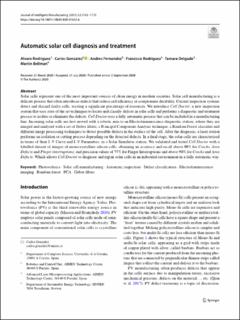| dc.contributor.author | Rodriguez, Alvaro | |
| dc.contributor.author | Gonzalez, Carlos | |
| dc.contributor.author | Fernandez, Andres | |
| dc.contributor.author | Rodriguez, Francisco | |
| dc.contributor.author | Delgado, Tamara | |
| dc.contributor.author | Bellmann, Martin Pawel | |
| dc.date.accessioned | 2021-08-19T08:22:29Z | |
| dc.date.available | 2021-08-19T08:22:29Z | |
| dc.date.created | 2021-03-21T14:19:41Z | |
| dc.date.issued | 2020 | |
| dc.identifier.citation | Journal of Intelligent Manufacturing. 2020, 32 1163-1172. | en_US |
| dc.identifier.issn | 0956-5515 | |
| dc.identifier.uri | https://hdl.handle.net/11250/2770216 | |
| dc.description.abstract | Solar cells represent one of the most important sources of clean energy in modern societies. Solar cell manufacturing is a delicate process that often introduces defects that reduce cell efficiency or compromise durability. Current inspection systems detect and discard faulty cells, wasting a significant percentage of resources. We introduce Cell Doctor, a new inspection system that uses state of the art techniques to locate and classify defects in solar cells and performs a diagnostic and treatment process to isolate or eliminate the defects. Cell Doctor uses a fully automatic process that can be included in a manufacturing line. Incoming solar cells are first moved with a robotic arm to an Electroluminescence diagnostic station, where they are imaged and analysed with a set of Gabor filters, a Principal Component Analysis technique, a Random Forest classifier and different image processing techniques to detect possible defects in the surface of the cell. After the diagnosis, a laser station performs an isolation or cutting process depending on the detected defects. In a final stage, the solar cells are characterised in terms of their I–V Curve and I–V Parameters, in a Solar Simulator station. We validated and tested Cell Doctor with a labelled dataset of images of monocrystalline silicon cells, obtaining an accuracy and recall above 90% for Cracks, Area Defects and Finger interruptions; and precision values of 77% for Finger Interruptions and above 90% for Cracks and Area Defects. Which allows Cell Doctor to diagnose and repair solar cells in an industrial environment in a fully automatic way. | en_US |
| dc.language.iso | eng | en_US |
| dc.publisher | Springer | en_US |
| dc.rights | Navngivelse 4.0 Internasjonal | * |
| dc.rights.uri | http://creativecommons.org/licenses/by/4.0/deed.no | * |
| dc.subject | Gabor filters | en_US |
| dc.subject | PCA | en_US |
| dc.subject | Random forest | en_US |
| dc.subject | Electroluminescence imaging | en_US |
| dc.subject | Defect classification | en_US |
| dc.subject | Automatic inspection | en_US |
| dc.subject | Solar cell manufacturing | en_US |
| dc.subject | Photovoltaics | en_US |
| dc.title | Automatic solar cell diagnosis and treatment | en_US |
| dc.type | Peer reviewed | en_US |
| dc.type | Journal article | en_US |
| dc.description.version | publishedVersion | en_US |
| dc.rights.holder | © The Author(s) 2020 | en_US |
| dc.source.pagenumber | 1163-1172 | en_US |
| dc.source.volume | 32 | en_US |
| dc.source.journal | Journal of Intelligent Manufacturing | en_US |
| dc.identifier.doi | 10.1007/s10845-020-01642-6 | |
| dc.identifier.cristin | 1899675 | |
| dc.relation.project | EC/H2020/679692 | en_US |
| cristin.ispublished | true | |
| cristin.fulltext | original | |
| cristin.qualitycode | 2 | |

